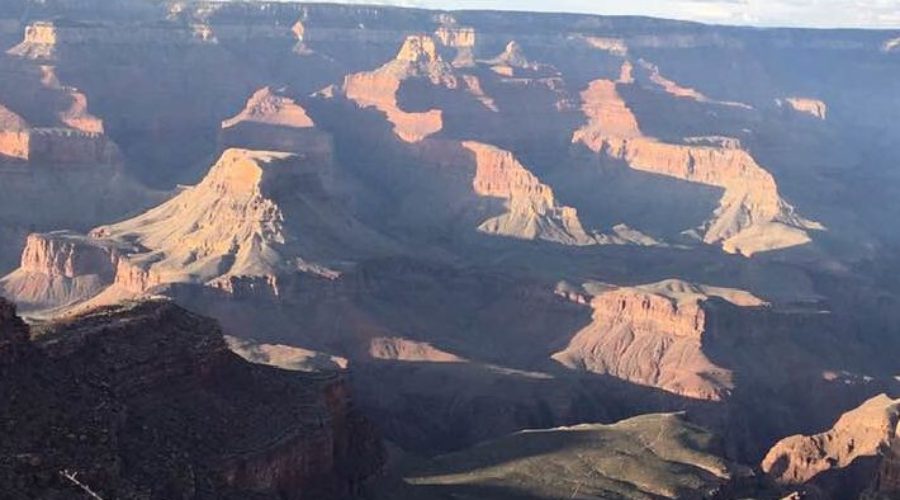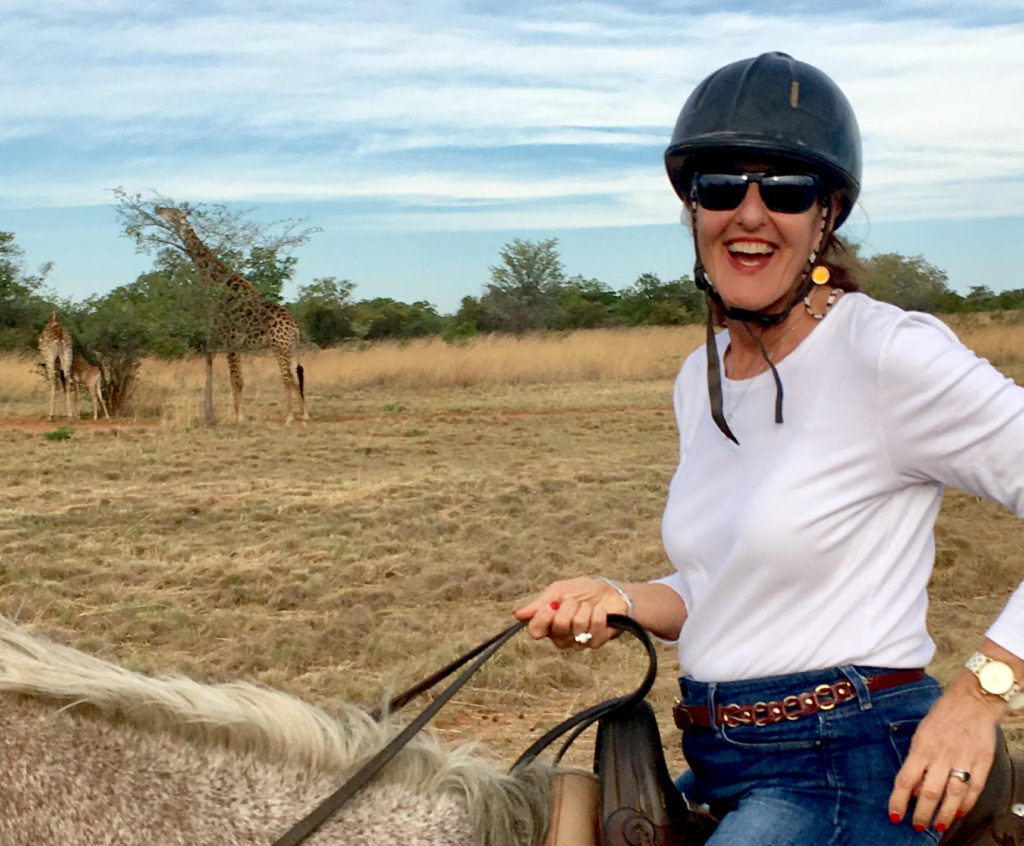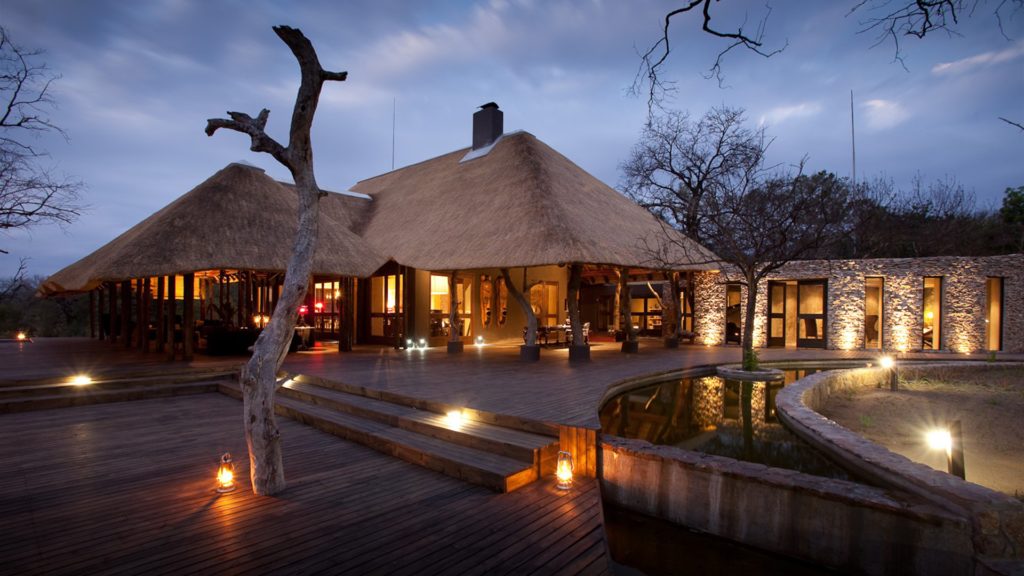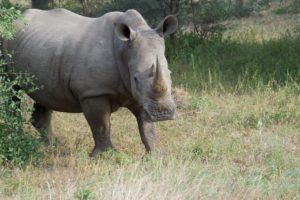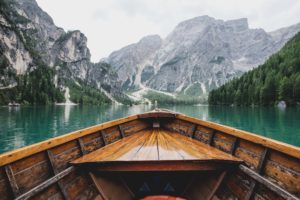Options for Boomers: How to Hike and/or Explore the Grand Canyon
The Grand Canyon is one of the wonders of the world, and somewhere everyone should try to visit. It’s incredible to stand at the Canyon Rim and look out. But to experience the true majesty, diversity and yes, spirituality of this unique place, you need to go deeper.
SOME INITIAL STATS TO PONDER:
*5 million people visit the Grand Canyon each year. Only 1% hike down to the Colorado River. (Be a part of the 1%….it can change your life!)
*The Bright Angel Trail from Rim to River is 7.5 miles with a 4,400 ft. descent. (The Bright Angel campground is 2 miles further along this trail); Another well-traveled route is the South Kaibab Trail, 7 miles from Rim to River, with a 4,800 ft. elevation loss. (FYI: for those with sensitivity to elevation, the Canyon’s South Rim is at 6,800 ft. Phantom Ranch on the Colorado River is at 2,072 ft.)
*Temperatures can vary between 30-40 degrees from Rim to River. In March, for example, an average Rim temperature ranges from 34 to 62 degrees Fahrenheit with chances of rain or light snow; at the River, the range is from 55 to 82 degrees. In July, an average Rim temperature is 74 degrees; at the River, the temperature will be 104 degrees.
*The Canyon can be extremely dangerous for those who are unprepared. In 2017, there were 20 fatalities; 290 Search & Rescue Missions; 1,135 Medical Emergencies (a large percentage of these were related to extreme heat exhaustion.)
For me, hiking the Grand Canyon from Rim to River was the Granddaddy of everything on my Bucket List. I’d stood at the Rim during previous visits admiring the glorious view, knowing what I could see from the top was just the smallest fraction of what lies beneath. I’d once ridden the mules from the South Rim to Indian Garden, halfway down the Bright Angel Trail. (This day trip is no longer available.) I’d even done a 4-night raft trip from Lee’s Ferry and looked up at the Canyon walls from the Colorado River. But, I knew I wasn’t done. I had to hike it.
Luckily for me, my daughter, Hayley is a passionate and skilled hiker. She agreed to take me on this adventure, and thought April (or October) would be a perfect weather month. She structured our hike as follows:
DAY 1: Hike down to the Colorado River via the South Kaibab trail, and sleep at Phantom Ranch campground.
DAY 2: Hike 4 miles halfway up the Bright Angel Trail to sleep at the Indian Garden campground.
DAY 3: Continue hiking up the Bright Angel Trail, and make it back to the Rim by mid-afternoon.
(For novice hikers, here’s a rule of thumb for your Grand Canyon adventure: for every hour you spend on your descent, double this number for your ascent. So, 6 hours down, 12 hours up.)
Hayley carried the bulk of our camping gear: food, extra water bladders, small backpacking stove and fuel, ultra light cookware, sleeping bags (we opted to go without a tent since the forecast was good), blow up sleeping pads, first aid kit, playing cards, etc. I carried my water for each day, my lunch, on-the-go snacks, and a few extra layers. My pack weighed under 20 pounds.
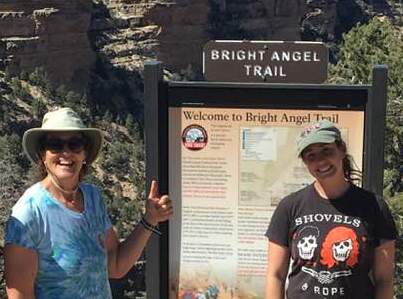
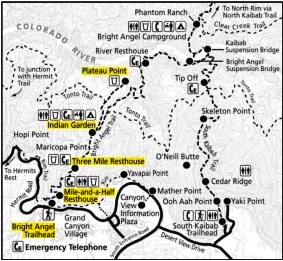
FOOD & WATER FOR THE HIKE:
FOOD: When you’re doing a rigorous hike like the Canyon, you burn calories at a much higher rate. For example, a 160 lb. hiker burns more than 400 calories per hour, depending on their pack weight, and intensity of the hike. (As a comparison, someone sitting at a desk burns 100 calories per hour.)
Make sure to bring lots of energy and calorie “add-ons” for meals. For example, if you’re having oatmeal for breakfast, sprinkle it liberally with walnuts, Craisins, chia seeds, etc. Lunches must be truly portable, like the reliable PB&J, accompanied by Trail Mix of peanuts, M&M’s, dried fruits. Salty snacks are crucial, like Fritos, nuts and jerky. Fuss-free camp dinners include freeze-dried packaged options from Backpacker’s Pantry – add water and stir. There are tasty options, like vegetarian curry, beef stroganoff and pastas. (And let’s not forget wine in those easy-to-carry little boxes!)
WATER: The Grand Canyon Park Service suggests you carry and drink 4 liters of water each hiking day. Professional hikers recommend one liter of water for every hour of hiking. For example, in the Canyon’s steep terrain, expect to hike about 1.5 miles per hour for your descent.
Be aware: there is NO WATER on the South Kaibab trail. There is drinking water at Phantom Ranch (which also has flush toilets) and Indian Garden (compost toilets here).
PHYSICALLY PREPARING FOR THE GRAND CANYON RIM TO RIVER HIKE
I’m 65 AND a flatlander from Miami. There was no local place I could truly prepare for a 4400 ft. elevation gain. I’ve been going to my local gym twice a week for 15 years. I’ve also walked 28 half marathons in the last 10 years. Even so, I am no “Iron Woman.”
To get ready for the Canyon, I purchased a 25 lb. weight vest -click to see what it looks like.
For eight months prior to the hike, I wore the weight vest on the treadmill set at an incline and walked at least 45 minutes twice a week. In the last month before the hike, I did this routine five days a week. Also in the last month before the hike, I alternated between the weight vest, and my actual hiking backpack filled with about 20 pounds (also doing 45 minutes with it on at an incline). I added the Stairmaster to my workout…doing about 8 minutes on that killer machine.
PREPARATIONS FOR HIKE WEEK (If Camping Out)
For hiking from the South Rim, you’ll probably want to fly into Phoenix, rent a car, and head to Flagstaff (Southwest Airlines has lots of flights – and NO BAGGAGE CHARGES). The day before the hike, you’ll need to visit one of Flagstaff’s grocery stores and stock up on the food for your hike. (Although there are food stores inside the Park, you won’t find anywhere near the selection, and of course, costs will be higher.)
The night before the hike, plan to sleep at the Canyon Rim so you can get an early start on your hike. Book EXTREMELY early with Xanterra, as accommodations are tough to come by. Here is a link to lodging at the Rim. https://www.grandcanyonlodges.com/lodging/
If you get shut out of staying at the Rim, you can stay directly outside the Park at Tusayan, only 7 miles from the South Rim.
SLEEPING AT PHANTOM RANCH LODGE
You’ve probably heard of Phantom Ranch Lodge, and are wondering why we needed to camp out, instead of staying in the Lodge.
To be frank, the chances of securing a bed at the Phantom Ranch Lodge are slim. Previously, there was a phone-in system –an absolute nightmare. Let’s say you wanted to stay at Phantom Ranch anytime in April 2019. On April 1, 2018, at the moment the Reservation Line opened, you started dialing them. Derek and I both tried repeatedly (about 75 times each) to get through. This took more than one hour. When I finally got through (Derek never did), I was told April 2019 was already completely booked out. No luck.
Now things have changed. There is an online lottery, 15 months in advance. I have not tried the system, but with the knowledge that Phantom Ranch only has 90 beds, (and some are reserved for the Mule trips), I don’t believe you should be overly optimistic about securing a bed at the bottom. Here is the link to the Phantom Ranch lottery. https://secure.grandcanyonlodges.com/phantom-ranch-lottery/availability.
Price of a bed at Phantom Ranch at one of the unisex dorms is $53 per person (hikers only). Cabins for 2 at Phantom Ranch are $155 per night.
Here is general information about Phantom Ranch Lodge, including meal prices. https://www.grandcanyonlodges.com/lodging/phantom-ranch/
CAMPING OPTIONS
Securing a place at the Canyon campgrounds also requires diligent pre-planning. A Backcountry Permit is required for any overnight hike. The cost is $10 per permit, plus $8 per person per day. The Backcountry Information Center can receive up to a staggering 800 permit requests a day. It usually takes three to six weeks to process your request. To improve your chances of obtaining a permit, requests should be made on the first of the month, four months prior to the proposed start date. Here is a good reference for general information about obtaining a permit.
https://grandcanyon.com/planning/backcountry-permit-procedures/
Permits are valid for the trip leader, itinerary, number of people and dates specified. Both at Phantom Ranch and Indian Garden, a ranger did come by to ensure we had the proper permit. Here is a link to the permit application:
https://www.nps.gov/grca/planyourvisit/upload/permit-request.pdf
MY GEAR
For the Hike: Hiking backpack (covered in the blog “Finding the Right Hiking Backpack For You”); Leki trekking poles ; short and long sleeve technical shirt (I like Columbia’s); Under Armour sports bra; knee length workout pants; Tilley hat; Columbia lightweight rain jacket, sun block; sunglasses; Nalgene 1 liter hard plastic reusable water bottle; Wenzel 2 liter water bladder. I did take my iPhone for photos, and 2 auxiliary chargers. (There is electricity at Phantom Ranch in the bathroom. I saw some folks charging their phones there.)
At Camp: Comfortable sandals (many hikers use rubber clogs); long pants and long sleeve shirt (which I also slept in); fleece jacket, lightweight puffy jacket; beanie; sleeping bag rated to 20 degrees; inflatable air mattress. Remember, you have to carry out all your trash, so bring extra bags for this.
THE MULES
If the hike is not for you, but you still want to get under the Rim, you may opt to ride the mules from the South Rim to Phantom Ranch. The descent down the Bright Angel Trail takes approximately 5-1/2 hours. A box lunch is provided halfway down at Indian Garden. You’ll stay overnight at Phantom Ranch. Cabins have bunk beds, cold water sink, toilet, bedding, soap and hand towels. Showers and bath towels are available. In the evening, you’ll have a family-style meal at Phantom Ranch canteen. After breakfast the next morning, you’ll ride up the South Kaibab trail, about 5.5 hours. The cost is $605.81 for the first person; two people for $1056.62. More information here: https://www.grandcanyonlodges.com/plan/mule-rides/
Riders must be:
*At least 9 years old. Children under 18 must be accompanied by a parent or guardian.
*Must be at least 4’9” tall, and weigh less than 200 lbs.
*Be able to understand instructions in English
HIKING GUIDE COMPANIES
If you don’t have a skilled and passionate hiker you can lure into being your private Sherpa (like I did – thank you, Hayley!), here is a list of Guiding Companies that currently hold permits for guided hiking services.
https://grandcanyon.com/planning/backcountry-guided-services-2/
WAS IT WORTH IT?
Yes, when you’re contemplating a Grand Canyon hike, there’s a great deal to consider. Lots of planning, (AND lots of praying you get the necessary permits).
Some people asked me if I’d had a moment on the trail where I asked myself “What am I doing here? Am I nuts?” That answer is “No.” Hiking the Canyon is one of the best things I’ve ever done. It was hard. I tortured my toes. I got some “gnarly” blisters on my feet. I huffed. I puffed, I sweated – but after all the work I’d done to prepare, I never doubted myself.
I learned so much (including one should ALWAYS land on your heels when you’re hiking down a trail). Viewing the Canyon’s immensity gives your life perspective: You’re not the center of the universe. You’re on earth for just the briefest millisecond. And perhaps my favorite realization: Don’t think you know something when you’re on the outside looking in (or in this case, looking down). You gotta’ get down in there to discover the magic that awaits.
As we say, when in doubt – choose ADVENTURE. I’m so glad I did.
Want More Safari Ideas?
Check This Out.




